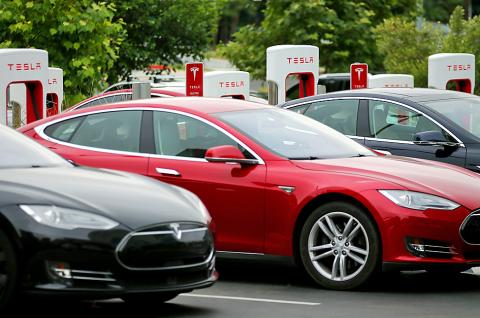The electric car has dropped out of favor in the nation that pioneered renewable energy.
Sales in Denmark of electrically chargeable vehicles, which include plug-in hybrids, plunged 60.5 percent in the first quarter of the year, compared with the first three months of last year, European Automobile Manufacturers Association data showed.
That contrasts with an increase of nearly 80 percent in neighboring Sweden and an average rise of 30 percent in the EU.

Photo: Reuters
The figures suggest that clean-energy vehicles still are not attractive enough to compete without some form of subsidy.
Denmark, a global leader in wind power whose own attempt at an electric car in the early 1980s famously flopped, used to be enthralled with them.
Its bicycle-loving people bought 5,298 of them in 2015, more than double the amount sold that year in Italy, which has a population more than 10 times the size of Denmark’s.
However, it turns out that those phenomenal sales figures had as much to do with convenience as with environmental concerns: Electric car dealers were for a long time spared the jaw-dropping import tax of 180 percent that Denmark applies on vehicles fueled by a conventional combustion engine.
In the fall of 2015, the Liberal-led government of Danish Prime Minister Lars Lokke Rasmussen announced the progressive phasing out of tax breaks on electric cars, citing budget constraints and a desire to level the playing field.
The new tax regime “completely killed the market,” Danish Electric Car Alliance head Laerke Flader said in an interview.
“Price really matters,” he said.
According to the government’s original plans, tax breaks were to have been phased out from last year to 2020, when they would be treated in the same way as fossil fuel-powered cars.
However, on April 18, having taken note of the drop in sales, the government decided to change the rules.
“It’s no secret electrical vehicle sales have been below what we expected a year and a half ago,” Danish Tax Minister Karsten Lauritzen said in a statement. “The agreed phase-in has turned out to be hard and that likely halted sales.”
The new rules mean the transition to a post-subsidy era has been postponed until at least 5,000 new electric cars are sold over the 2016 to 2018 period.
Tax breaks will in any case be progressively eliminated as of 2019, regardless of sales numbers.
The plan envisages a 40 percent registration tax minus a 10,000 kroner (US$1,500) deduction in 2019, with the tax rising to 65 percent in 2021, 90 percent in 2021 and 100 percent in 2022.
While sales of low or zero-emission cars continue to boom in Sweden thanks to a wide range of subsidies, including a five-year tax break and a 40,000 kronor (US$4,600) purchase premium, the Danish government’s U-turn has caused confusion, prompting many potential customers to either postpone or desist from their purchases.
Flader said electric car dealers have rolled back their sales drive as a result.
The electric car industry “doesn’t want to invest in a market that may not be there next year. They’d rather invest where conditions are better and predictable long-term,” Flader said.
One of the hardest hit is Tesla Inc, the global poster child of electric cars, whose Model S once dominated the Danish market.
However, Flader anticipates a rebound in sales as soon as dealerships are allowed to advertise tax-free prices again.

SEEKING CLARITY: Washington should not adopt measures that create uncertainties for ‘existing semiconductor investments,’ TSMC said referring to its US$165 billion in the US Taiwan Semiconductor Manufacturing Co (TSMC, 台積電) told the US that any future tariffs on Taiwanese semiconductors could reduce demand for chips and derail its pledge to increase its investment in Arizona. “New import restrictions could jeopardize current US leadership in the competitive technology industry and create uncertainties for many committed semiconductor capital projects in the US, including TSMC Arizona’s significant investment plan in Phoenix,” the chipmaker wrote in a letter to the US Department of Commerce. TSMC issued the warning in response to a solicitation for comments by the department on a possible tariff on semiconductor imports by US President Donald Trump’s

The government has launched a three-pronged strategy to attract local and international talent, aiming to position Taiwan as a new global hub following Nvidia Corp’s announcement that it has chosen Taipei as the site of its Taiwan headquarters. Nvidia cofounder and CEO Jensen Huang (黃仁勳) on Monday last week announced during his keynote speech at the Computex trade show in Taipei that the Nvidia Constellation, the company’s planned Taiwan headquarters, would be located in the Beitou-Shilin Technology Park (北投士林科技園區) in Taipei. Huang’s decision to establish a base in Taiwan is “primarily due to Taiwan’s talent pool and its strength in the semiconductor

Industrial production expanded 22.31 percent annually last month to 107.51, as increases in demand for high-performance computing (HPC) and artificial intelligence (AI) applications drove demand for locally-made chips and components. The manufacturing production index climbed 23.68 percent year-on-year to 108.37, marking the 14th consecutive month of increase, the Ministry of Economic Affairs said. In the first four months of this year, industrial and manufacturing production indices expanded 14.31 percent and 15.22 percent year-on-year, ministry data showed. The growth momentum is to extend into this month, with the manufacturing production index expected to rise between 11 percent and 15.1 percent annually, Department of Statistics

An earnings report from semiconductor giant and artificial intelligence (AI) bellwether Nvidia Corp takes center stage for Wall Street this week, as stocks hit a speed bump of worries over US federal deficits driving up Treasury yields. US equities pulled back last week after a torrid rally, as investors turned their attention to tax and spending legislation poised to swell the US government’s US$36 trillion in debt. Long-dated US Treasury yields rose amid the fiscal worries, with the 30-year yield topping 5 percent and hitting its highest level since late 2023. Stocks were dealt another blow on Friday when US President Donald